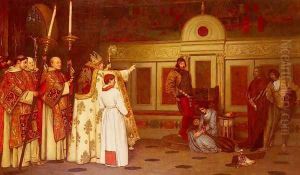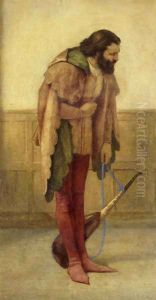Sir James Dromgole Linton Paintings
Sir James Dromgole Linton was a prominent British painter and illustrator, born in 1840 and passing away in 1916. His career was marked by a distinctive contribution to the Victorian art scene, particularly within the genres of watercolor painting and illustration. Linton's work encapsulated a range of subjects, including historical scenes, landscapes, and portraits, showcasing his versatility and mastery over his medium.
Linton's early life was shaped by his passion for art, leading him to pursue training at prestigious institutions. His talent was recognized early on, and he quickly established himself as a significant figure within the art communities of the time. Throughout his career, Linton was involved with several important art societies, including the Royal Institute of Painters in Water Colours, where he served as President from 1884 until his death in 1916. This position not only highlighted his influence in the realm of watercolor painting but also allowed him to mentor upcoming artists and advocate for the medium.
Beyond his contributions to watercolor painting, Linton was also known for his exquisite illustrations, which graced the pages of numerous publications of the era. His work in illustration demonstrated a keen eye for detail and a profound ability to convey narrative and emotion, traits that endeared him to both his contemporaries and the public.
Linton's legacy is not only preserved through his artworks but also through his knighthood, which was bestowed upon him in 1885 in recognition of his contributions to the art world and society at large. His death in 1916 marked the end of an era, but his influence persisted, inspiring future generations of artists to explore and innovate within the medium of watercolor. Today, Sir James Dromgole Linton is remembered as a pivotal figure in Victorian art, whose work continues to be celebrated for its beauty, skill, and emotional depth.

